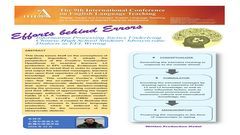报告详情
Efforts behind Errors: Information Processing Tactics Underlying Chinese High School Students’ Idiosyncratic Dialects in EFL Writing
编号:226
访问权限:仅限参会人
更新:2020-10-04 22:20:12
浏览:412次
摘要
This study bases itself on the conceptions of cognitive linguistics. It aligns with the perspective of the Creative Construction Hypothesis in examining learners’ L2 production in EFL writing. Evidences from the research reveal that in order to organise and output the intended messages, learners draw upon their repertoire of both L1 and L2 knowledge and other non-linguistic elements to accomplish the writing tasks. This confirms Corder’s (1981) view that the so-called “errors” are but learners’ idiosyncratic dialects manifesting their active choices and decision-making during the process of meaning construction and their efforts of approximating the target language patterns, rather than “passive” habits of L1. A "written production model" inspired by Levelt’s (1993) speech production model, is created to illustrate the information process in learners’ language production. Five categories of information processing tactics are identified that account for the learners' production of idiosyncratic dialects.
关键词
creative construction hypothesis; error; interlanguage development;idiosyncratic dialect;
报告人
史 伟华
副主任 上海外国语大学附属外国语学校稿件作者
全部评论
重要日期
-
会议日期
10月16日
2020
至10月18日
2020
-
09月05日 2020
报告提交截止日期
-
10月08日 2020
摘要截稿日期
-
10月08日 2020
摘要录用通知日期
-
10月14日 2020
初稿截稿日期
-
10月14日 2020
初稿录用通知日期
-
10月18日 2020
注册截止日期
主办单位
中国英汉语比较研究会英语教学研究分会
承办单位
北京师范大学
联系方式
- Mr. Liu
- le******@126.com
- +86********
历届会议
-
2023年10月13日 中国 Chengdu
第十届中国英语教学国际研讨会 -
2017年10月20日 中国 西安市
第八届中国英语教学国际研讨会



发表评论